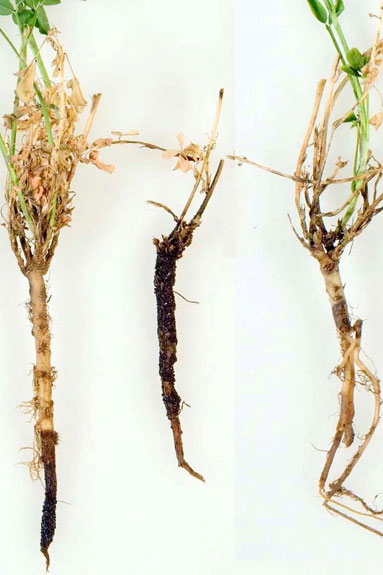The stem and root rot diseases are the most serious. Plant breeders have incorporated disease resistance into modern alfalfa varieties, mostly eliminating the problems of bacterial wilt and fusarium wilt.

However, phytophthora root rot, anthracnose and sometimes verticillium wilt can be problems under the right conditions. Researchers in Minnesota and Wisconsin have identified Aphanomyces root rot (race 2) and brown root rot as “emerging” alfalfa root diseases in their states.
Here is a brief description of the important alfalfa root rot diseases.
Phytophthora root rot
Phytophthora root is a fungal disease that causes loss of stand on heavy or poorly drained soils. The disease pathogen is activated under wet soil conditions and may attack both seedlings and older plants.
Dark brown decayed areas on the tap root 2 to 3 inches below the soil surface are early indicators. One-month-old to two-month-old seedlings are most vulnerable. Seed treatment on resistant varieties can improve stand development. However, treating a susceptible variety, such as Vernal, is probably not helpful.
Aphanomyces root rot
Resistant varieties have been available for many years. However, reports in Wisconsin and Minnesota of Aphanomyces disease in alfalfa have become more frequent in recent years, possibly due to the emergence of a “race 2” strain of the disease.
The pathogen can apparently persist in soil or in other plants for long periods of time. Seedlings may die (damping off) at an early stage of development. Older seedlings are yellow and stunted; when Aphanomyces and Phytophthora occur together, the problem is much worse.
Brown root rot
In 2003, brown root rot of alfalfa was reported for the first time in Wisconsin and Minnesota. The disease has probably been present for much longer, but not recognized. The fungus is slow-growing and prefers cool soil temperatures (less than 60°F).
Symptoms may not become visible until after the third winter due to slow disease development. The fungus rots plant roots mostly in spring and fall and can severely weaken plants and contribute to winter kill. Stunted and dead plants appear in two-year-old to three-year-old stands with brown sunken lesions on taproots.
Infected plants may start to grow in the spring, then stop growing and die because the tap root has rotted off. The fungus also causes disease in other perennial forage legumes and winter wheat. FG
Jim Isleib
Michigan State University Extension
isleibj@msu.edu
—Michigan State University Extension News
PHOTO
TOP: Photo courtesy of Marvin Hall, Penn State University.








